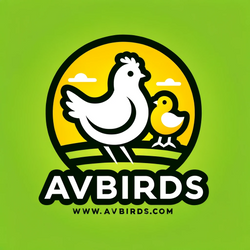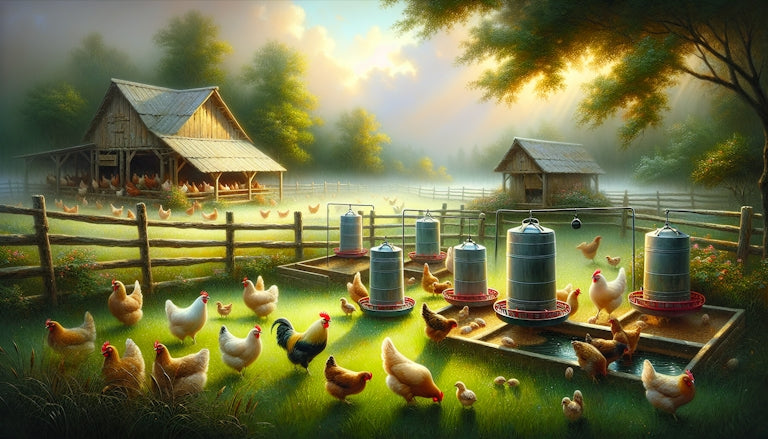Choosing the right chicken feeders and waterers for your coop can keep your flock healthy, cut down on waste, and save you time. You might be sweeping up spilled feed each morning, so investing in the proper equipment can reduce waste by up to 60% (Green Washing Index). In this guide, you’ll learn about feeder and waterer styles, materials, installation tips, and cleaning routines to keep your birds happy and hydrated.
Types of Chicken Feeders
Gravity Feeders
Gravity feeders use a container that automatically refills a tray as chickens peck at it. They’re simple, affordable, and come in sizes for backyard flocks or larger setups (Thrifty Homesteader).
Tube Feeders
Tube feeders consist of a long cylinder with feed ports along its length. They minimize waste by keeping grain contained and protect feed from dirt.
Treadle Feeders
Treadle feeders have a pressure plate that opens access when a chicken steps on it, which cuts down on rodents and feed spillage.
Automatic Feeders
Automatic or mechanized feeders feature a hopper, a drive system, and a dispensing mechanism. They dramatically reduce labor and can pay for themselves within a year thanks to lower feed waste and higher consumption rates (Canadian Poultry Magazine).
Materials for Feeders
Plastic vs Metal
- Plastic feeders are lightweight, affordable, and easy to clean.
- Galvanized steel or aluminum units last longer and withstand pecking and weather.
Wood Options
Wooden feeders can blend into a rustic coop aesthetic but need regular sealing to resist moisture and mold.
Types of Chicken Waterers
Open Bowls
Open bowl waterers are cheap and let birds drink freely, but they’re prone to debris and require daily cleaning.
Nipple Drinker Systems
Nipple drinkers use valves that release water only when a chicken pecks them, cutting down on splashing and contamination.
Heated Waterers
In cold climates, a heated poultry fountain prevents freezing and ensures a steady supply of liquid water through winter.
Materials for Waterers
- UV-resistant plastic is lightweight, durable, and safe for water consumption.
- Stainless steel or galvanized metal resists rust and stands up to pecking.
Choose a material that balances budget, durability, and ease of cleaning.
Installing Feeders and Waterers
- Pick a weather-protected spot on level ground.
- Mount or hang feeders at the height of your chickens’ backs so they don’t scratch debris inside (Agrimaster).
- Position waterers away from droppings but within easy reach.
- If you’re raising chicks, set up your chick brooder supplies first, then adjust feeder height as they grow.
Cleaning and Maintenance
- Empty and scrub feeder trays or hoppers weekly.
- Rinse waterers daily, checking for algae or debris.
- Inspect for cracks or rust, replacing parts before they cause leaks or contamination.
- In winter, check heated bases to ensure they stay ice-free.
Feeding and Watering Tips
- Provide one feeder and one waterer per 5–10 birds to reduce competition.
- Monitor feed intake and adjust rations to prevent obesity or malnutrition.
- Offer fresh, clean water—chickens drink about one pint daily, and more on hot days (Bless This Mess Please).
- Elevate feed and water containers slightly to keep droppings out.
DIY Feeders and Waterers
Bucket Kits
Kits like the Suplklz DIY 4-Port transform a 5-gallon bucket into a no-waste feeder, cutting feed loss by 47% at under $20 (Green Washing Index).
PVC and Tote Feeders
You can build gravity or tube feeders from PVC pipe or repurposed totes. Just drill feeding ports, smooth the edges, and secure the unit above a tray.
Key Takeaways
- Gravity, tube, treadle, and automatic feeders each suit different flock sizes and budgets.
- Plastic, metal, or wood options affect durability and cleaning ease.
- Open bowls, nipple systems, and heated fountains cover all climate needs.
- Proper installation, routine cleaning, and feeding practices keep waste low and birds healthy.
- DIY setups offer cost savings and customization.
Ready to upgrade your coop? Try one new feeder or waterer this week and see the difference in feed waste and flock health. Have a favorite setup or tip? Share it in the comments below so fellow keepers can benefit!

